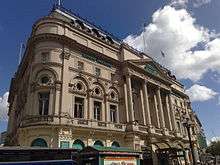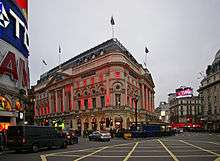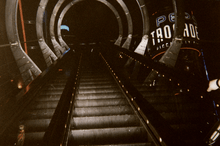London Trocadero
The London Trocadero was an entertainment complex on Coventry Street, with a rear entrance in Shaftesbury Avenue, London. It was originally built in 1896 as a restaurant, which closed in 1965. In 1984, the complex reopened as an exhibition and entertainment space, which operated until 2014. Part of the building was opened as a hotel in 2020.

The complex incorporates a number of separate historic London buildings, including the old London Pavilion Theatre, that have in the past hosted the Palace of Varieties, the New Private Subscription Theatre, the Royal Albion Theatre, the Argyll Subscription Rooms, the Eden Theatre and the Trocadero Restaurant.
The name Trocadero indirectly derives from the Battle of Trocadero in 1823, through the Palais du Trocadéro in Paris, named after the French victory. Since at least 1919, the Trocadero has been abbreviated to the Troc or Chicarito, and under that name it appears in a poem by John Betjeman.[1]
Opening

The Trocadero Restaurant of J. Lyons and Co. opened in 1896 on a site on Coventry Street, near the theatres of the West End, which had been formerly occupied by the notorious Argyll Rooms, where wealthy men hired prostitutes. A one time maître d'hôtel of the Trocadero was French-born Raymond Monbiot, great-grandfather of the journalist and environmentalist George Monbiot.
The new settings were done in an Opera Baroque style, and the various Trocaderos of the English-speaking world have derived their names from this original, the epitome of grand Edwardian catering. Murals on Arthurian themes decorated the grand staircase, and the Long Bar catered to gentlemen only. During World War I, the Trocadero initiated the first "concert tea": tea was served in the Empire Hall, accompanied by a full concert programme. After the war, cabaret was a feature of the Grill Room. The Trocadero closed on 13 February 1965.
Relaunch in 1984
In 1984, the Trocadero was redeveloped as a tourist-oriented entertainment, cinema and shopping complex. Providing 450,000 square feet (42,000 m2) of leisure space, it was the largest leisure scheme in the United Kingdom at the time; only being matched 19 years later by the similar sized Xscape development in Castleford.

It retained the external Baroque facade, but gutted the interior and added a Guinness Book of World Records Exhibition. But tenants were limited, and the half-finished development was eventually sold to Burford Group plc, led by Nick Leslau and Nigel Wray.[2] Nickelodeon UK used to broadcast live from there from 1994 until 1996 when they moved to Rathbone Place, and the place received a boost in the late 1990s with the addition of sponsorship from Pepsi, and Sega as an anchor tenant. The launch of SegaWorld, a large amusement arcade occurred on 7 September 1996, which included a large statue of Sonic the Hedgehog over the front entrance. Pepsi sponsored The Pepsi Max Drop and from 1997 the Pepsi IMAX cinema, the first 3D IMAX cinema in the UK. It was also home to the second series of Channel 4's daily reality show The Salon.
However, resultant visitor numbers were poor, and the Guinness Records exhibition closed in the mid-1990s. Following the loss of Sega's sponsorship in 1999, Segaworld became Funland, named after the original arcade that had operated on the basement floor of the building since 1990,[3] and was subsequently reduced in size. The Pepsi-sponsored IMAX cinema closed in March 2000 shortly after the newer London IMAX opened on the South Bank, and the Drop Ride closed around the same time (the Drop Ride was relocated to Funland in Hayling Island, which has no relation to Funland in the Trocadero beyond the name). Remains of old attractions could still be seen around the centre, such as a wall with a gun-barrel motif that used to house the James Bond: License to Thrill ride. The top floors were kept open until autumn 2002, when they were closed and the disused escalator was blocked off with a drinks machine. This was the original entrance to Segaworld when Funland occupied the lower floors. In October 2005, the centre was used as a backdrop for the final scenes of Madonna's "Hung Up" video.[4]
Redevelopment from 2005
Criterion Capital acquired the Trocadero in 2005, and unveiled plans to comprehensively redevelop the site while retaining the listed facade.[5] In 2009, a plan to build a pod hotel with 500 budget rooms inside the building was announced.[6] A new plan for a 583-bedroom hotel including "pod rooms", apartments, shops and a rooftop bar was approved by Westminster City Council in August 2012.[7] In March 2014, Criterion announced plans to open a TK Maxx in the centre, 5 years after it was blocked by the Crown Estate.[8] After further delays and changes of plan, Criterion opened the hotel in 2020: the Zedwell Piccadilly has 728 windowless rooms and a large rooftop bar.[9][10]
The 'rocket' escalator was removed in May 2011, and what remained of Funland closed in July 2011. The locked entrance and a handful of left-over arcade games and attractions remained in a much quieter, emptier Trocadero centre with spaces at basement level for street dancers. Despite some online articles indicating that the venue would permanently close on 25 February 2014,[11] only a few areas were removed and others remained open while renovation and plans to build the hotel continued.[12] The Cineworld cinema closed on 21 September 2014 and was replaced by a new Picturehouse cinema called Picturehouse Central, which opened on 19 June 2015.[13]
Plans were submitted in May 2020 to develop parts of the building's basement into a mosque[14] but were later withdrawn.
See also
References
- Jocelyn Brooke, John Betjeman, Chapter 3, Poems online at ourcivilisation.com, accessed 15 May 2013
- Kemp, Kenny (10 February 2002). "How the Westway was won by tycoon". Sunday Herald. Retrieved 26 August 2008.
- http://tedsegablog.blogspot.com/2017/06/the-rise-and-fall-of-london-trocadero.html
- "Videography "Hung up"". 2005. Archived from the original on 20 July 2009. Retrieved 30 April 2010.
- David Doyle (9 May 2008). "Criterion's £100m plans for Trocadero get Westminster go-ahead". Property Week. Retrieved 9 October 2008.
- Ruth Bloomfield (11 August 2009). "Trocadero centre to be turned into budget 500-room pod hotel". Evening Standard. Retrieved 17 January 2013.
- Mirra Bar-Hillel (16 August 2012). "Trocadero to be transformed into Tokyo-style 'pod' hotel". Evening Standard. Retrieved 17 January 2013.
- https://www.standard.co.uk/news/london/tk-maxx-to-open-piccadilly-superstore-on-trocadero-site-five-years-after-west-end-snub-9181446.html
- "Zedwell Piccadilly". Expedia. Retrieved 15 July 2020.
- Sheppard, Owen (5 March 2018). "Rooftop bar to be built on the Trocadero in expanded hotel plan". Evening Standard. Retrieved 15 July 2020.
- "London Trocadero will close for good on February 25, 2014". UK Arcade Racers. 14 February 2014. Retrieved 14 February 2014.
- "Don't panic! The best bits of the Trocadero will live to see another day". Time Out. 20 February 2014. Retrieved 9 October 2014.
- http://now-here-this.timeout.com/2015/06/11/exclusive-look-at-the-new-picturehouse-central-cinema-in-londons-west-end/
- "Mosque plans submitted for London's Trocadero". BBC News. 20 May 2020. Retrieved 15 July 2020.
External links
| Wikimedia Commons has media related to London Trocadero. |
- Official website: London Trocadero at the Wayback Machine (archived 17 July 2014)
- Trocadero Restaurant launch, early days and banquets
- History of the London Trocadero with archive images